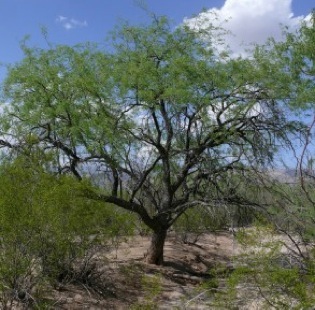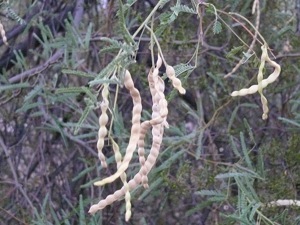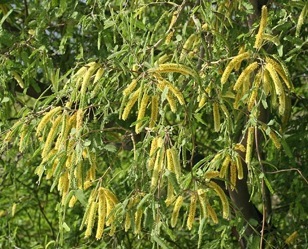Mesquite’s More Than Flavoring: It’s Food
If Euell Gibbons was still around he might ask, “have you ever eaten a Mesquite tree?” rather than his famous questions about pines.
Many people have used the Mesquite flavor while barbecuing. But long before there was a “barbi” American natives were harvesting pods off at least six species of Mesquite. Among them were Prosopis chillensis, Proscopis glandulosa, Proscopis glandulosa var. glandulosa, Proscopis glandulosa var. torreyanna, Proscopis pubescens, and Proscopis velutina, the latter perhaps the most preferred.
Among the Indians using the Mesquite were the Apache, Cahuilla, Chiricahua, Cocopa, Comanche, Diegueno, Havasupai, Hualapai, Isleta, Kamia, Kawaiisu, Keres, Kiowa, Laguna, Luiseno, Mahuna, Maricopa, Mohave, Paiute, Papago, Pima, Pima Gila River, Seri, Yavapai, and Yuma. They knew a good thing when they tasted it. There are almost as many uses for the tree as there were tribes. Main uses were young pods eaten raw or cooked, mature tan pods ground up whole to make a gluten-free flour; or, the pods and seeds separated and ground separately for different uses.
Those other uses include: Grinding, adding water, and letting the mixture ferment; pods used as a sugar substitute (they’re 16% sugar); the tree’s white resinous secretions used to make candy or chewed like gum; fresh pods pounded and juice drank like milk; pounded beans mixed with sea lion oil; pods rotted in a hole for a month then ground into a flour to make a beverage; beans boiled, cooled then pressed into cakes; catkins sucked for sweetness; toasted seeds ground and added to coffee; flowers eaten raw or roasted, often formed into dumplings then stored.
While making wine was a way of preserving food and its calories in the desert southwest, the native range, preservation was rather easy, dry the pods and seeds on the roof. Thus we must conclude they made wine for the same reasons we do today… for health reasons of course….
But, before you do anything with a pod, taste it. They aren’t always sweet or of good flavor. If you don’t like the taste of the pods on a particular tree, try a different tree. Also avoid moldy pods and any pods stained black (which means always harvest off the tree, not the ground. Pods on the ground can be infected with a fungus that can cause insanity and a very painful death. Leave them alone.)
The pods are 13.9 g protein, 3.0 g fat, 78.3 g total carbohydrate, 27.7 g fiber, and 4.8 g ash. Seeds contain 65.2 g protein, 7.8 g fat, 21.8 g total carbohydrate, 2.8 g fiber, and 5.2 g ash. Per 100 g, the flower contains: 21.0 g protein, 3.2 g fat, 65.8 g total carbohydrate, 15.5 g fiber, 10.0 g ash, 1,310 mg Ca, and 400 mg phosphorus. Analyzed differently the entire pod is 14.35% water, 1.64% oil, 16.36% starch, 30.25% glucose, 0.85% nitrogenous material, 5.81% tannin-like material, 3.5% mineral salts, and 27.24% cellulose. If you are using the leaves as fodder for animals they are 19.0 g protein, 2.9 g fat, 69.6 g total carbohydrate, 21.6 g fiber, 8.5 g ash, and 2,080 mg Ca.
And just what wildlife likes those leaves and fruit? Cattle, horses, domestic sheep, goats, mules, and burros. It is not unusual to see these trees browsed up to the height these animal’s can reach. Mesquite seeds are an important part of the diet of mice, kangaroo rats, woodrats, chipmunks, ground squirrels, rock squirrels, cottontail, skunks, quail, doves, ravens, the black-tailed prairie dog, black-tailed jackrabbit, porcupine, raccoon, coyote, collared peccary, white-tailed deer, mule deer, wild turkey, and mallard ducks. However, cattle on a poor diet can be made ill by eating mesquite.
Besides food mesquite has had various medicinal applications as well. Water and alcoholic extracts are antibacterial. However, using the wood in the fireplace has caused dermatitis, as has working with seasoned wood.
Generally said there are three common species of mesquite; the Honey Mesquite (Proscopis glandulosa), Screwbean Mesquite ( Proscopis pubescens), and Velvet Mesquite ( Proscopis velutina.) The Velvet Mesquite is also the largest of the mesquite species. Low-branched, broad spreading thorny shrub or small tree it has a well-developed crown. It can grow 30 feet tall, and 20 feet wide, with a two-foot trunk. If damaged when young by frost, fire, or browsing, it can sprout multiple trunks — coppicing –and form a shrub. One might confuse the many mesquite with the many Acacias. However, the mesquite always have 10 stamen (the male part of the flower) and Acacias have more than 10 stamen per flower.
Proscopis (pro-SO-piss) is Greek for burdock, a reference to the tree’s thorns. But if you go back further in the language it means ‘towards abundance’, from the Greek word ‘pros’, meaning ‘towards’, and ‘Opis’, wife of Saturn, the Greek goddess of abundance and agriculture. ‘Mesquite’ is the English version of the Nahuatl Indian name for the tree, ‘misquitl’ which means ‘bark that tans’ a reference to the pods because Mesquite bark is often green and involved in photosynthesis. Velutina, from Latin, meaning velvety and is said vel-oo-TEE-nuh though in Brazilian Portuguese it is said Veh-lou-chee-AN-nah.
Green Deane’s “Itemized” Plant Profile
IDENTIFICATION: Velvet Mesquite’s bark is reddish-brown and smooth when young, older trees have bark that’s gray-brown, rough, thick, and shredded into long, narrow strips. Young branches are green and grow in a zig-zag pattern. At the base of each leaf on young branches you will find two inch-long yellow thorns in pairs. Leaves are bipinnate and grow alternatively on a branch. Three to six inches long the leaves are dark to dusky green with a gray, hairy surface and paler undersides. Flowers are yellow-green, catkins about 2-3 inches long. Blossoms have bell-shaped calyces, and 5 petals. Pods are straight or slightly curved, flat, about 3-8 inches long, singly, or in drooping clusters. Seed pods are tan and covered in short, velvety hairs when young.
TIME OF YEAR: Pods mature in early summer, dropping by early fall. Often fruit twice, once before seasonal rains and once after.
ENVIRONMENT: Thrives in arid areas but also responds well to irrigation. Mesquite are members of the pea and restore nitrogen to the soil.
METHOD OF PREPARATION: Numerous uses. Young pods raw or cooked, usually boiled. Pods and beans ground up together into a flour, or the pods and beans used separately.




